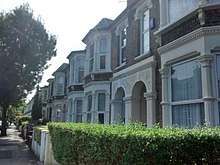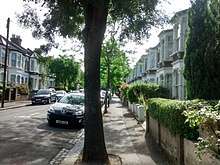Bushwood, Leytonstone
The Bushwood Area of Leytonstone, commonly referred to as just Bushwood, is a part of Leytonstone in East London which borders the greenery of Wanstead Flats.[1] It is located south of the apex of High Road Leytonstone & Bush Road, just off the Green Man roundabout. The area is determined by the curved boundary of the road called ‘Bushwood’ to the east and south, where it extends along Lister Road, and by the High Road Leytonstone to the west and north west.[2][3]

History
Named after the ancient woodland of Bush Wood, which it borders, Bushwood includes a Conservation Area. Designated by Waltham Forest Council in March 1973, The Browning Road Conservation Area consists of terraces of ‘Georgian’ cottages. These were preserved as a reminder of the special historic and architectural interest present during the rapid urbanisation of the then small hamlet of Leytonstone following the introduction of the steam railway to the area in 1856, and date as far back as the early 19th century.
The majority of the quiet streets consist of tree-lined rows of characterful Victorian and Edwardian houses, displaying period features. These have been popular with young professionals and those moving from Islington and Hackney.[4][5][6][7][8] Later additions include some 20th century apartment blocks.
Notable features

Popular for its proximity to greenery and the open parkland and lakes of Wanstead Flats and Wanstead Park, the Bushwood Area of Leytonstone has swift transport links into central London via Leytonstone Central Line station (approx. 17 minutes to Liverpool Street) as well as many local amenities in the form of restaurants, cafes and shops on High Road Leytonstone.[9][10][11][12]
Victorian keystone faces
Many Victorian houses in Bushwood have decorative keystones above their entrances in the form of faces. Mainly found in Leyspring, Leybourne, Barclay and Woodville Roads, the use of these elements was influenced by the Neoclassical/Greek/Gothic revival introduced by Romanticism in the early Victorian period (mid 1800s). The most common figure is that of a bearded man with long, heavy beard which is probably referring to a water-related pagan divinity like Poseidon (the Roman god Neptune) or Father Thames. Other identifiable themes include the Green Man and various monarchs.
The North Star
The North Star Public House is situated on Browning Road[13] in the heart of the Conservation Area. Originally two cottages converted into a Public House it is thought that the name of this establishment comes as a direct result of a sailing voyage taken by the founder of the North Star, Frederick Wildsmith which involved his returning from India with a monkey and so fond was he of this memory, he decided to name the pub after the twin-masted, 253 ton Brigantine in which he had travelled. The North Star’s first mention is in the 1858 Rate book with Frederick listed as a ‘beer retailer’ in the 1891 census at the tender age of 23.
Henry Reynolds Park
Accessible via Browning Road, at the northernmost part of Bushwood, is Henry Reynolds Park which includes a playground for children of all ages and basketball shooting practice area.[14] Originally a gravel pit and Green Man Pond, it was drained in the 1970s to form the present day park with its sunken gardens.
Gallery
 Sculpture by Stephen Duncan in Bushwood Area of Leytonstone
Sculpture by Stephen Duncan in Bushwood Area of Leytonstone Row of Victorian houses in Bushwood Area of Leytonstone
Row of Victorian houses in Bushwood Area of Leytonstone
References
- "The Guardian - Let's Move To Leytonstone". 21 September 2018.
- "Leytonstoner - Bushwood Yard Sale".
- "The Emmerson Papers - Cut Out & Keep Guide To Leytonstone".
- "Four London areas for £250k budgets with future price-growth potential". Homes and Property. 2017-01-10. Retrieved 2017-04-29.
- Peter Walker, for. "6 of London's most happening neighborhoods". CNN. Retrieved 2017-04-29.
- "Up And Coming Areas In The UK 2017".
- "Daily Express - THIS area of London will be the 2018 property hotspot".
- City AM (2 February 2020). "The High Streets Paved With Gold". City AM.
- "Evening Standard Article on Neighbouring Wanstead". Evening Standard. Retrieved 2017-04-28.
- "City AM article on Leytonstone". City AM. Retrieved 2017-06-19.
- "Where To Live Along The Central Line For Speedy Commute, Value For Money and A Great Social Life". Evening Standard Homes And Property. 2017-06-21.
- "Timeout - Guide To Leytonstone 2015".
- "Article in Leytonstoner on Browning Road in Bushwood Area of Leytonstone". Leytonstoner. 2017-04-13. Retrieved 2017-04-28.
- "Henry Reynolds Park Re-opens".